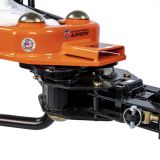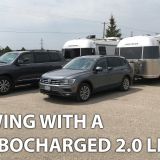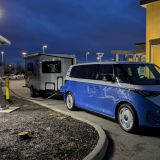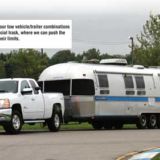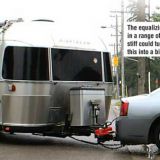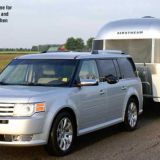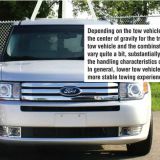
Testing Electronic Sway Control
A unique system that allows extreme maneuverability for your trailer when you need it.
 In the 1970s, Airstream and Holiday Rambler were the best-selling, high-end trailers. The Airstream was similar to today’s Airstream, while a Holiday Rambler was a conventional, square trailer with better construction and appointments. It also had a suspension system that rode smoothly, but did nothing for handling. Consequently, if you wanted a trailer that handled well and towed easy you bought an Airstream. If you wanted a trailer with maximized interior space you bought a Holiday Rambler.
In the 1970s, Airstream and Holiday Rambler were the best-selling, high-end trailers. The Airstream was similar to today’s Airstream, while a Holiday Rambler was a conventional, square trailer with better construction and appointments. It also had a suspension system that rode smoothly, but did nothing for handling. Consequently, if you wanted a trailer that handled well and towed easy you bought an Airstream. If you wanted a trailer with maximized interior space you bought a Holiday Rambler.
In order to answer the handling objection, Holiday Rambler resorted to the expertise of manufacturer KelseyHayes to develop an automatic braking system that would actuate the trailer brakes on the right and left side only. This unit was about one-foot in diameter, 16 inches tall and had to be mounted at the center-rear of the trailer. Essentially, it was a pendulum that detected side-sway in order to apply the individual trailer brakes. While the system worked if you were in serious trouble, it did nothing to improve driving feel the rest of the time. It was also very expensive, so few people selected the option.
Today, electronic systems are made much smaller and less expensive. Last year, Tuson RV Brakes, a company that manufactures several high-end braking components for trailers, introduced a modern version of electronic sway control. The unit is a small 4 x 6-inch box, which is located on the trailer chassis eight feet behind the ball, and the cost is much less, at only $499. It can be installed on any trailer with electric brakes in three to five hours.
 I feel tall trailers are where this technology is most likely to save the day. So, to test the system we selected a 34-foot Tracer trailer weighing 7,200 pounds with opposing slide outs. We connected the trailer to a Mercedes GL SUV that has been modified for towing. The modifications amounted to strengthening the hitch receiver and changing the tires to a more optimal size. For a large SUV, this is a quick handling vehicle that delivers pretty good feedback. It also has a fairly sophisticated electronic stability program. For specific purposes of the test, we ran wires from the right and left trailer brakes to two lights mounted on the windshield, so we could see when the unit was actuating.
I feel tall trailers are where this technology is most likely to save the day. So, to test the system we selected a 34-foot Tracer trailer weighing 7,200 pounds with opposing slide outs. We connected the trailer to a Mercedes GL SUV that has been modified for towing. The modifications amounted to strengthening the hitch receiver and changing the tires to a more optimal size. For a large SUV, this is a quick handling vehicle that delivers pretty good feedback. It also has a fairly sophisticated electronic stability program. For specific purposes of the test, we ran wires from the right and left trailer brakes to two lights mounted on the windshield, so we could see when the unit was actuating.
"One concern I had was that the system might be too sensitive and intrusive when not needed."
We generally do two tests for handling. The first is to run through a 100- foot slalom course (set out by using traffic cones) and the second is a series of sudden lane changes, using two 12-foot lanes with a 50-foot opening. One concern I had was that the system might be too sensitive and intrusive when not needed. However, it ran smoothly through the slalom and never actuated. During the lane change, the trailer swung out and took out a few cones, and then the system briefly actuated to line it back up. There was no secondary swing.
Next, we took the combination out on the open part of the track, which doubles as a runway. We had a convertible running in front with a cameraman shooting back at the combination and another camera man in the Mercedes to video the lights on the device. On the track, I yanked the wheel one way and then before the trailer could completely change direction, I yanked it back the other way. This will cause almost any trailer to start to sway and a tall trailer such as the Tracer will tend to continue to sway. Even in the vehicle, it was a very abrupt maneuver despite being belted in. Although, the cameraman braced himself, he could not hold the camera in position on the lights. However, when we stopped to look at the footage it was almost boring as the sway control system took out all the drama.
 I thought, well if this is going to look like anything, I am going to have to really toss it hard. I kicked the cameraman out so I would not put him at risk and not worry about a camera flying around. On this run, I pushed it so hard at one point that some of our staff watching from 300 feet away said they could see the whole white roof of the trailer as it became airborne. In the video you can see the smoke come off the left trailer tires where they locked-up when actuated by the system. In the car, I felt like I had complete control and the video still looks nowhere near as dramatic as the experience was.
I thought, well if this is going to look like anything, I am going to have to really toss it hard. I kicked the cameraman out so I would not put him at risk and not worry about a camera flying around. On this run, I pushed it so hard at one point that some of our staff watching from 300 feet away said they could see the whole white roof of the trailer as it became airborne. In the video you can see the smoke come off the left trailer tires where they locked-up when actuated by the system. In the car, I felt like I had complete control and the video still looks nowhere near as dramatic as the experience was.
"I was very impressed with the results and suggested to some industry leaders that they should make it standard on all travel trailers."
I was very impressed with the results and suggested to some industry leaders that they should make it standard on all travel trailers. That is not likely to happen, but the system is well worth considering for anyone that does substantial towing. I certainly would not have been able to do what I did without it. Even someone with far less towing experience than I have could have handled the Tracer under those circumstances.
Like the automatic braking system of the 1970s you will rarely, if ever, feel the Tuson electronic sway control actuate in normal driving circumstances. It will only be noticeable in an extreme maneuver. But, in that instant, it can save your trailer and tow vehicle.
Consider it like you do your car’s air bag system: you hope you never need it but should the occasion arise, you will be very glad it’s there.
The electronic sway control system doesn’t replace a proper hitch set up or conventional sway controls, but think of it like a belt with suspenders.
Originally published in RV Lifestyle, Volume 43, No. 7.

